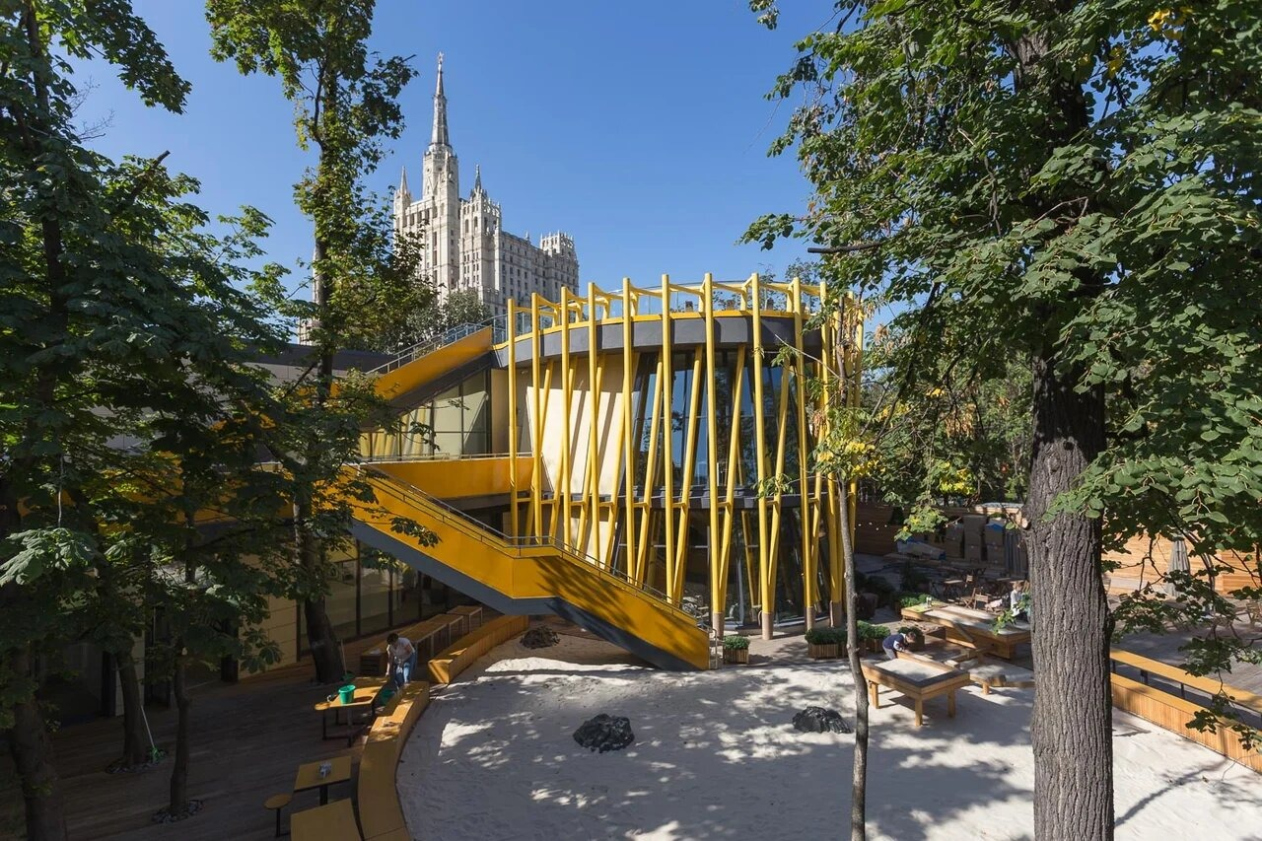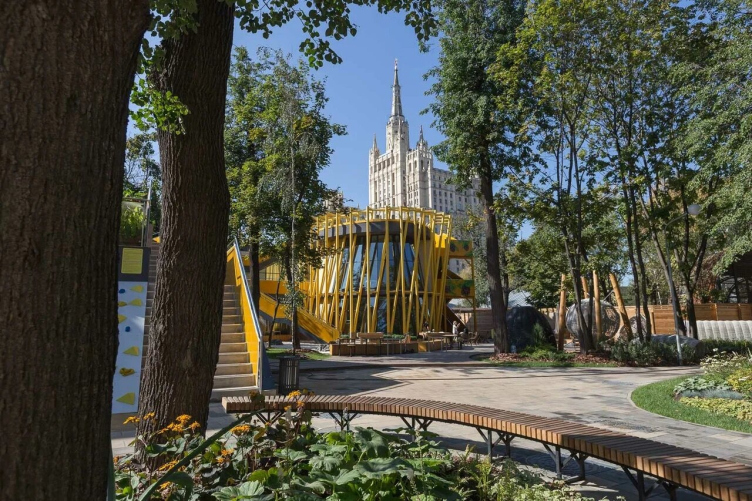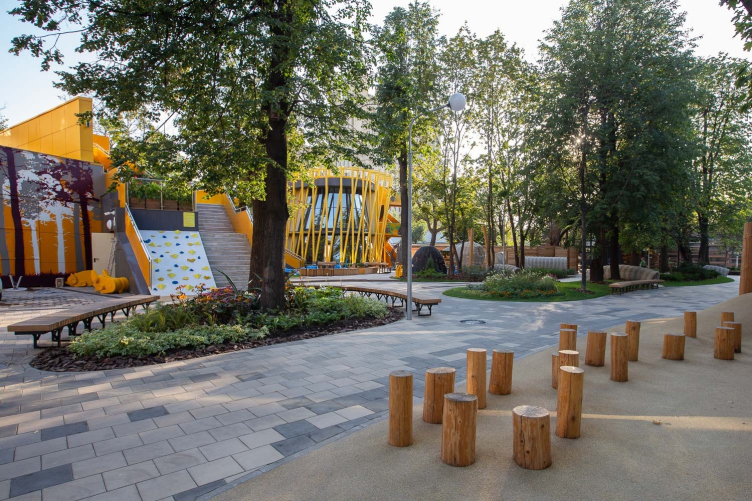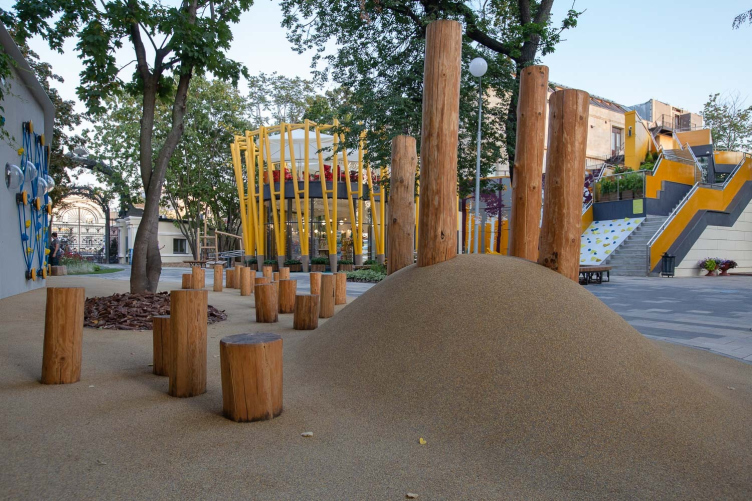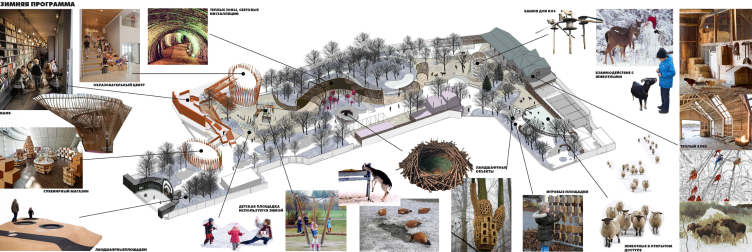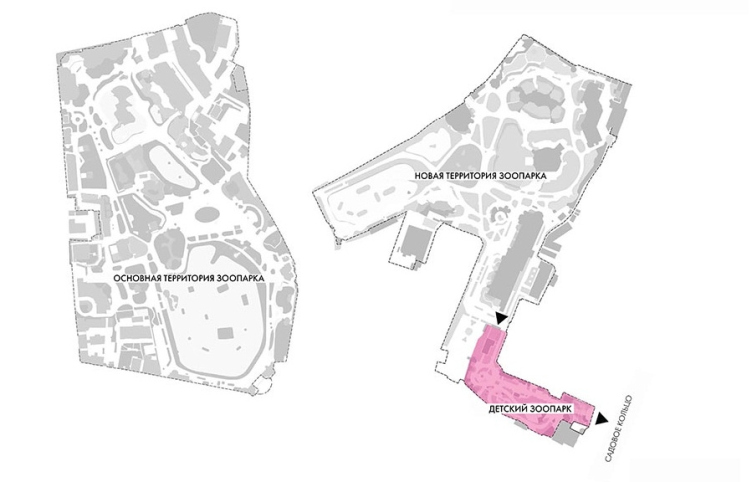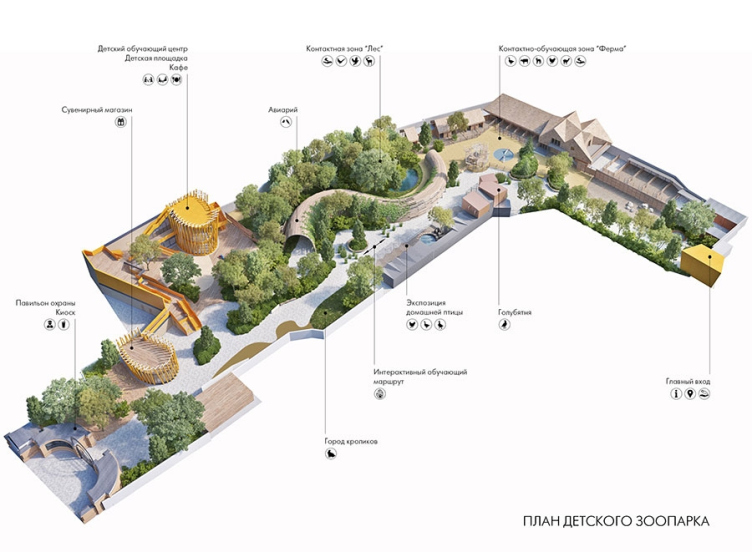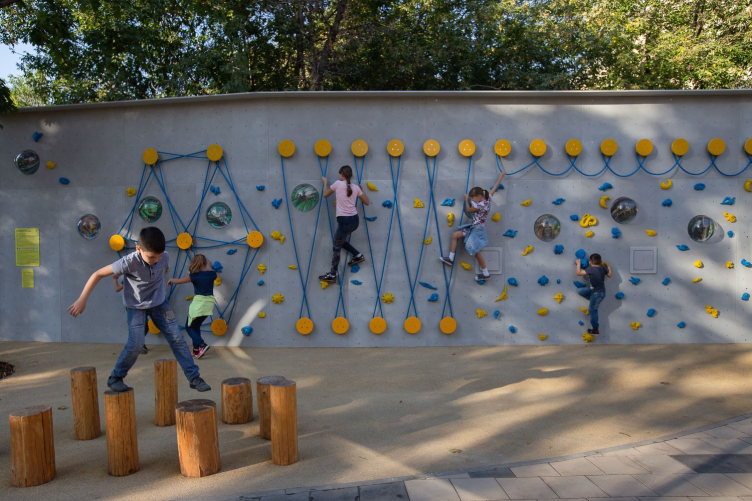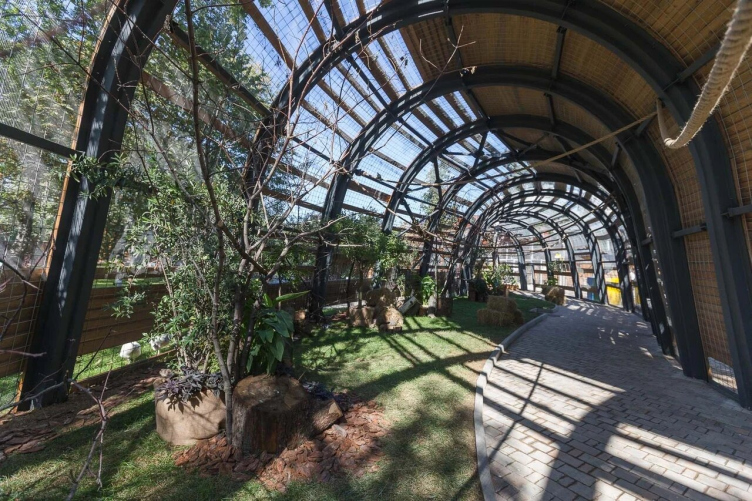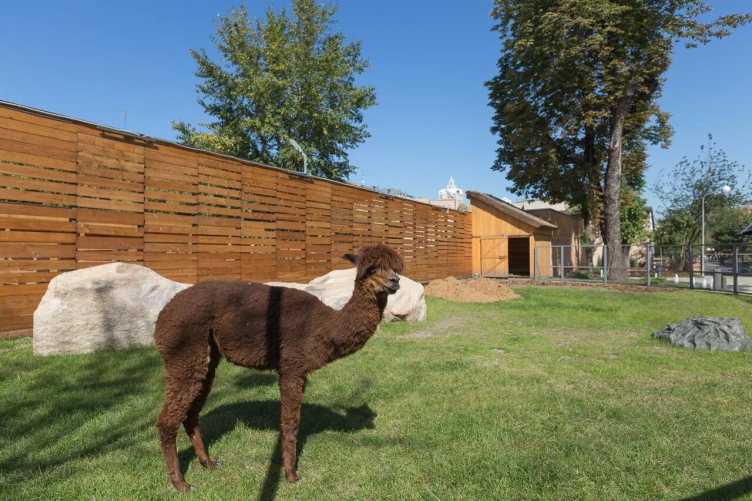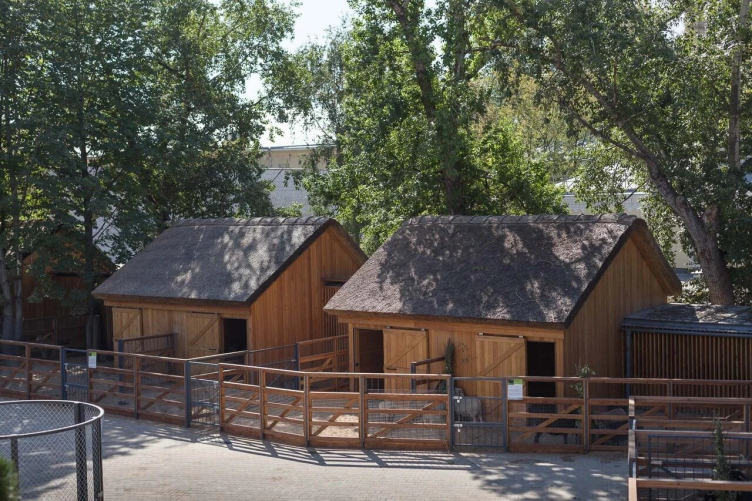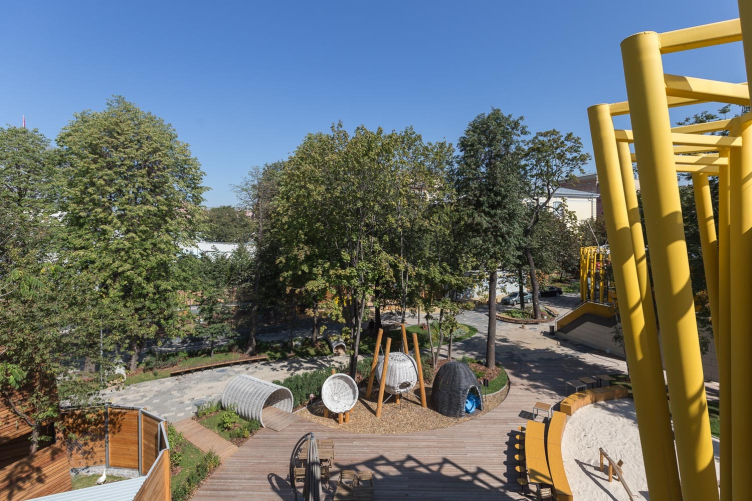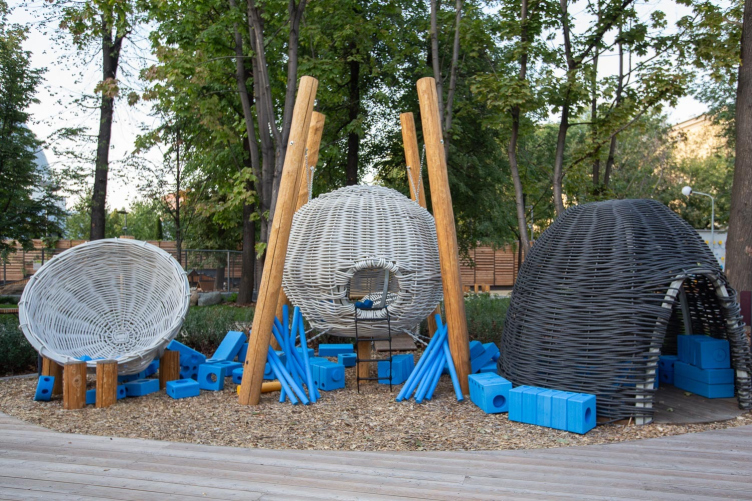The list of projects that any decent megalopolis must have includes, among other things, a zoo. This has been the custom since about the end of the XVII century, when in Europe court menageries were replaced by public places of such kind — botanical and zoological gardens, in which the enlightened citizens took great pleasure in getting acquainted with the flora and fauna of the faraway lands and continents. However, whilst the format of presenting vegetation was formed pretty soon, remaining unchanged ever since, the format of demonstrating the animals has been constantly changing over the last 300 years, effectively becoming a mirror image of the changes in the relationship of man and nature in general and representatives of the animal world in particular.
The approaches to animal keeping kept changing over several centuries: cramped cages gave way to spacious aviaries, then came the system of “islands”, and still today there is an ongoing search for a method to keep the animals coexisting within a confined territory that would be humane and comfortable for animals and safe for humans. During the XX century, many renowned architects, such as Berthold Lubetkin and Ove Arup (Penguin Pool in London), Norman Foster (Elephant House in Copenhagen), BIG (Panda enclosure in Copenhagen), 3XN (Aquarium in Copenhagen), Fay Architekten and Liquid Architekten (monkey house in Frankfurt-am-Mein), Hascher Jehle (monkey house in Stuttgart), and others tried their hand at designing such spaces.
However, even considering the accumulated experience and a fundamental change in the human stance towards animal protection, it would be a mistake to think that the optimum format of animal keeping has been finally found. And it comes as no surprise that a lot of people, haunted by the idea of animals that are suffering in steel cages, do not visit zoos on general principle.
The children′s zone of the Moscow Zoo
Copyright: © WOWHAUS
A sad fairytale
The Moscow Zoo was opened in 1864 and is one of the oldest zoos in Europe; at one time, it was also considered to be one of the most advanced. However, already in the middle of the last century it became clear that the 21-hectare territory in the center of the city cannot provide the necessary comfort for the animals. In the 1980’s, a chunk of land in the north part of the Bitsa Park was allotted for a new zoo. However, the good intentions of transferring the zoo to a more suitable place ran into antagonism from the local residents, whose concerns in those perestroika days outweighed the arguments coming from the specialists. Since then, the zoo survived a general reconstruction of the 1990’s, when thanks to Luzhkov’s good graces, it got weird Disney-Land-style pavilions and numerous sculptures by Zurab Tsereteli, the biggest one of which, named “Tree of Fairytales”, can serve as a great illustration of a hard everyday life of the Moscow Zoo, whose inhabitants are locked up in the center of one of the world’s largest megalopolises.
Since that time, no fundamental changes in either structural or functional systems of the zoo took place — that is, up until 2015, when a decision was made about the necessity of an overhaul of the so-called “children’s zone”, a narrow L-shaped strip of the new territory of the zoo, which spills over to the Garden Ring and essentially serves as the entrance corridor for the visitors coming from that side.
The children′s zone of the Moscow Zoo
Copyright: © WOWHAUS
The burden of discoveries
To develop the new concept of the children’s zone of the Moscow Zoo, in 2015 the city invited Wowhaus, who shortly before that already began working on one of the innovative projects — the City Farm in the All-Russia Exhibition Center. And for both of the locations the architects were able to propose not only the up-to-date form, but also unconventional approach to ideology and the program, fundamentally changing all of the notions of how people and animals can coexist and interact within a city.
The children′s zone of the Moscow Zoo
Copyright: © WOWHAUS
One of the primary tasks of the project was to bust some of the negative associations. Anna Ishchenko, the General Director of Wowhaus, comments on the self-imposed task: “If you talk to random people on the street, you will find that many people give a very negative feedback to the very “zoo” term, they will go like “oh, a zoo, it’s so terrible, it’s a prison, how can you ever get involved with designing something like that?” Or worse yet: “Is it going to be a petting zoo where children squeeze the animals till they’re numb, and then die from depression?” And when we tried to explain to them that it was not going to be that way, and that our attitude was quite different, people just did not believe us. We, however, did understand that this could and had to be a fundamentally different space with a fundamentally different system of relationships, with a concept of humane coexistence of man and animals, which is more and more actively spreading around the world. And we posed for ourselves a task of demonstrating this new approach to solving this problem here in Russia.”
The children′s zone of the Moscow Zoo
Copyright: © WOWHAUS
Interestingly, it has become a good tradition for Wowhaus to bust stereotypes, reinventing old typologies, such as parks, waterfronts, and “outdoor cinemas”, or creating new ones, such as city farms or museum parks. When asked how it turns out that time after time his company is pioneering new typologies, the partner of the bureau, Oleg Shapiro answers: “Each new architectural or town-planning task is a challenge, and we spend considerable time searching for the solution. This is why we believe that it’s better to spend our time inventing something new than just making a mediocre copy of something that’s already been there. This is why every time we try to discover something new for ourselves and for others, hopefully.”
Like a museum, only a living one
Discovering the new typology was by no means an easy task to do. The thing is that in this country zoos are governed by the Ministry of Culture and are considered to be a variety of museums, the only difference from their brothers in respectable status being that their exhibits are still alive, with all the consequences that come with it. Therefore, the reassembling of the children’s zone of the Moscow Zoo was done with consideration for the long list of mandatory requirements for the comfort of animals, visitors, and, last but not least, employees.
However, architects, zoo employees, biologists, ornithologists, zoologists, and animal psychologists, as well as experts of the research company KB23, who joined the team of the project for analyzing the context of developing the new functional and program strategies, extended this list still further by adding a considerable number of positions describing the modern notions of how the museum must look and operate, turning in front of our eyes from a place of passive accumulation of information into multifunctional space that ensures an interactive educational process.
Project of reorganizing the Minor Territory of the Moscow Zoo © Wowhaus, 2015-2016
Copyright: © WOWHAUS
In order to form an interactive educational process, the team of architects, together with psychologists, sociologists, and biologists, developed a methodology of presenting the information about animals, which became the key to building the entire structure of the children’s zoo.
According to the architects, “The educational process is built around a game of simulating the animals. For example, rabbits hide in their holes, and the children can also crawl into the tunnel of artificial vine, resembling a furrow, situated on the opposite side. Alpacas and goats skip over rocks, and children can also skip over rocks and wooden constructions, and so on. What we are ultimately getting is a projection — the child looks at the animals, trying to simulate what they are doing. There is no necessity for long drawn-out lectures, because you can see everything firsthand. The plaques, of course, are also there, serving as an addition source of information.”
The path of cognition
The plan of the children’s zone of the Moscow Zoo looks like the “L” letter, and is essentially a broken corridor that links the new territory of the zoo to the Garden Ring. The width of the passage is under 65 meters, the length being 300 meters.
The children′s zone of the Moscow Zoo. The simplified master plan
Copyright: © WOWHAUS
The architects laid two routes inside this passage, narrow as it is, by which the visitors will be able to make an exciting journey either to the world of domesticated animals, or, if they are already tired of watching the main part of the zoo, taking in the details of the exposition, they can quickly proceed to the exit. The main route, sophisticated, full of attractors and special edutainment stops, is meant for children who will come here once to become a regular visitor or maybe come back a few times but will always remember the great memories about how he or she was first exposed to the world of animals, could watch the busy life of birds in the aviary, get pushed around by the not-so-sheepish sheep asking for a treat, or understand that rabbits are not only valuable fur but first of all bright personalities and great athletes.
All these impressions and adventures are carefully thought out and distributed along the winding route, allowing the visitors to alternate the exposure to scientific information with various simulation games, as well as with contacts with the animals and many other intellectual and physical activities. The architects designed it in such a way that a few-hundred-meter route includes ten main thematic blocks: a shop, an educational center with a cafe, a “rabbit city”, an aviary, a zone of domestic birds, a pigeon house, a contact area with a “goat mount”, a “farm”, and a technical zone.
The children′s zone of the Moscow Zoo
Copyright: © WOWHAUS
Nests, tunnels, and mountains
For each of the blocks, the architects came up with an image of its own, yet still based on the common designer theme of the entire children’s zoo — a paraphrase of the natural elements, but without any direct imitation or playing with literally associations, which did indeed produce a very bleak impression before the reconstruction. In the image of each block, one can easily see a prototype, which was subjected to a thorough architectural arrangement, tying the outward plastique and the constructive skeleton into a single volumetric composition.
Immediately after the entrance to the children’s zone, the visitors are greeted by two most prominent, because of their imposing size and complexity, modules of the block: the store and the educational center. This place will host hobby groups and lectures, and it will also be the meeting point for the guided tours. The facades of the buildings with an oval plan are formed by the crossed tilted yellow stands, which the architects themselves liken to birds’ nests. Each of the blocks is surrounded by a sophisticated system of staircases, ramps, terraces, and overpasses, with a few playgrounds situated at different levels forming their own adventurous ecosystem.
The children′s zone of the Moscow Zoo
Copyright: © WOWHAUS
Between the shop and the center, there is a large playground with various games, including a unique erector set, developed in collaboration with the biologist Dmitry Knorre, who also invented the table game “Evolution” and adapted it for the Moscow Zoo in such a way that children can try their hand at coming up with new species, combining bodily parts of real animals in unusual sci-fi combinations.
The children′s zone of the Moscow Zoo
Copyright: © WOWHAUS
Nearby, starts the S-shaped tunnel of the aviary that also remotely resembles a nest thanks to its shell of wooden planks, which press the mesh down to the metallic framework. The aviary is designed in such a way as to give the birds that live inside an opportunity to independently control the degree of interacting with the visitors. The birds can walk on the ground, sit on the branches, or fly away into the depth of the lush vegetation in the curves of the tunnel, where the visitors cannot get.
The children′s zone of the Moscow Zoo
Copyright: © WOWHAUS
Similarly, with a division into public and private spaces, are organized the aviaries for domestic birds and the ungulates. Even the inhabitants of the contact zone can choose, in which part of the pen they choose to stay. However, it seems as though for this part of the park they choose the most communicative and the most voracious animals; so much so that the visitor himself will probably want to hide from their importunate interest to the contents of his pockets. All you have left to do is beat a hasty retreat and take a timeout near the enclosures with melancholic alpacas who with equal tranquility take the treats and pose for the photographs.
The children′s zone of the Moscow Zoo
Copyright: © WOWHAUS
Like a lighthouse that marks the “breaking point” on the territory of the children’s zoo, rises the “Czar of the Mountain” tower that all the visitors take for yet another children’s attraction, while in fact this sophisticated agglomerate of constructions and playgrounds was designed solely for the entertainment of the goat society, whose members, just as they do in their natural habitat, adore climbing and bouncing from one ledge to another. And, in order to make sure that the goats do not get bored climbing up and down the same route, the “Mountain” is engineered in such a way that it can be changed and augmented with new obstacles. And, of course, time, multiplied by the energy of the horned users, will add new “challenging zones” to this construction.
Behind the contact venue, there is the only traditional architectural element — the “farm” — which looks as if it were carried over here by some tender caring tornado from somewhere in the Austrian Alps. The pitched roofs, covered with trimmed straw, look extremely traditional, in sharp contrast to the modernist “nests” of yellow stands. This place, however, is the “rest home” for the inhabitants of the zoo, and the maintenance rooms are also situated here, so the reserved traditional look is the tribute to the function, as well as a means to avoid attracting the visitors’ attention any more than necessary.
The children′s zone of the Moscow Zoo
Copyright: © WOWHAUS
The yellow color of knowledge
What the design of the infrastructure objects and navigation have in common is the yellow color, which we already mentioned in the part about the design of the shop and the educational center. “Yellow color is to be seen across the entire territory. We used it to mark all of the information and game elements, so as to make them highly visible and easily discerned by the visitors from among the multitude of objects that perform various functions. There are also small information modules that are spread out across the territory as reflections of our main info center. For the little ones, these modules are of no interest, of course, but for those children who are a little bit older, and who want to learn more about the inhabitants of the zoo, and about their lives in natural environment, these will come in very handy. All the more so, because we developed different types of information presentation, laying our main stress on the gamification format” — comments the role of this color in the overall design Anastasia Izmakova, the leading architect of the project, responsible for the designer supervision.
The children′s zone of the Moscow Zoo
Copyright: © WOWHAUS
Emergency
The extremely compact territory of the children’s zone of the Moscow Zoo, includes a huge number of various architectural, designer, educational, and entertainment ideas, bright and inspiring. The density of original ideas and solutions per square meter is simply other-worldly. And, as it often happens in our realities, the number of unconventional elements spawned a geometric progression of difficulties at the stages of approval and implementation.
The main loss of the project was the forced abandonment of using the bearing wooden structures. Ensuring fire safety, taking into account the large estimated number of visitors and the proximity of neighboring residential and office buildings, necessitated the replacement of all wood-glued structures with metal ones. In addition, the architects had to abandon the use of natural wood in the braid of the “nests” on the playgrounds and in the decoration of the enclosures. The experience of using the natural tree branches in the “Krasnogvardeiskie Prudy” and “Serp i Molot” parks showed that this natural material soon breaks down, not being able to withstand the sheer energy of the little players, and therefore does not meet the safety requirements. The architects were able to keep the wood in the decoration of the small architectural forms, in the railings, and, partially, in the decoration of the enclosures’ facades.
The children′s zone of the Moscow Zoo
Copyright: © WOWHAUS
The project of the children’s zoo became a doubtless success, and yet another discovery for Wowhaus, but, at the same time, one of the most complex projects in the history of the company, a four years’ battle for the preservation and implementation of all those ideas, which the architects found together with the guest experts and the employees of the zoo in order to change, once and for all, our notion of what a modern zoo must look like.

